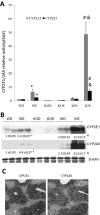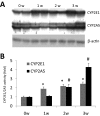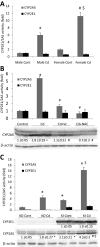Ethanol induction of CYP2A5: permissive role for CYP2E1
- PMID: 21051534
- PMCID: PMC3033694
- DOI: 10.1124/dmd.110.035691
Ethanol induction of CYP2A5: permissive role for CYP2E1
Abstract
CYP2A5 metabolizes xenobiotics and activates hepatocarcinogens, and induction occurs in response to hepatic damage and cellular stress. We evaluated whether ethanol can elevate CYP2A5 and whether CYP2E1 plays a role in the ethanol induction of CYP2A5. Wild-type (WT), CYP2E1 knockout (KO), and CYP2E1 knockin (KI) mice were fed ethanol for 3 weeks. Ethanol increased CYP2E1 and CYP2A5 protein and activity in WT mice but not in the KO mice. Induction of CYP2A5 (and CYP2E1) was restored in the KI mice. Ethanol induction of CYP2A5 occurred only after CYP2E1 was first induced. Immunohistochemical staining revealed that CYP2E1 and CYP2A5 colocalize to the same zones in the liver. Ethanol also elevated CYP2A5 mRNA levels in WT and KI mice but not in KO mice. Induction of CYP2A5 by cadmium was partially decreased in KO mice compared with WT or KI mice. Ethanol elevated CYP2A4 mRNA levels in all mice although the extent of induction was lowest in the KO mice. In summary, ethanol elevated mouse hepatic CYP2A5 levels, which may be of toxicological significance because CYP2A5 metabolizes nicotine and other drugs and activates hepatocarcinogens. Induction of CYP2A5 by ethanol is potentiated by the induction of CYP2E1. We speculate that ethanol induction of CYP2E1 followed by increases in reactive oxygen species and activation of Nrf2 are important steps in the mechanism by which ethanol induces CYP2A5. The possibility that induction of CYP2E1 is permissive for the induction of CYP2A5 may reflect a new contribution by CYP2E1 to the actions of ethanol.
Figures






Similar articles
-
Ethanol induction of CYP2A5: role of CYP2E1-ROS-Nrf2 pathway.Toxicol Sci. 2012 Aug;128(2):427-38. doi: 10.1093/toxsci/kfs164. Epub 2012 May 2. Toxicol Sci. 2012. PMID: 22552773 Free PMC article.
-
Acute cadmium chloride administration induces hepatic and renal CYP2A5 mRNA, protein and activity in the mouse: involvement of transcription factor NRF2.Toxicol Lett. 2004 Mar 21;148(3):199-210. doi: 10.1016/j.toxlet.2003.10.029. Toxicol Lett. 2004. PMID: 15041070
-
Cytochrome P450 2E1 potentiates ethanol induction of hypoxia and HIF-1α in vivo.Free Radic Biol Med. 2013 Oct;63:175-86. doi: 10.1016/j.freeradbiomed.2013.05.009. Epub 2013 May 10. Free Radic Biol Med. 2013. PMID: 23669278 Free PMC article.
-
Alcoholic Liver Disease: from CYP2E1 to CYP2A5.Curr Mol Pharmacol. 2017;10(3):172-178. doi: 10.2174/1874467208666150817111846. Curr Mol Pharmacol. 2017. PMID: 26278389 Free PMC article. Review.
-
Nrf2 and antioxidant defense against CYP2E1 toxicity.Expert Opin Drug Metab Toxicol. 2009 Oct;5(10):1223-44. doi: 10.1517/17425250903143769. Expert Opin Drug Metab Toxicol. 2009. PMID: 19671018 Review.
Cited by
-
Ethanol induction of CYP2A5: role of CYP2E1-ROS-Nrf2 pathway.Toxicol Sci. 2012 Aug;128(2):427-38. doi: 10.1093/toxsci/kfs164. Epub 2012 May 2. Toxicol Sci. 2012. PMID: 22552773 Free PMC article.
-
Alcoholic fatty liver is enhanced in CYP2A5 knockout mice: The role of the PPARα-FGF21 axis.Toxicology. 2017 Mar 15;379:12-21. doi: 10.1016/j.tox.2017.01.016. Epub 2017 Jan 25. Toxicology. 2017. PMID: 28131861 Free PMC article.
-
Effects of Chronic Alcohol Intake on the Composition of the Ensemble of Drug-Metabolizing Enzymes and Transporters in the Human Liver.J Xenobiot. 2025 Jan 31;15(1):20. doi: 10.3390/jox15010020. J Xenobiot. 2025. PMID: 39997363 Free PMC article.
-
Gut Commensal Fungi Protect Against Acetaminophen-Induced Hepatotoxicity by Reducing Cyp2a5 Expression in Mice.Front Microbiol. 2022 Jul 12;13:944416. doi: 10.3389/fmicb.2022.944416. eCollection 2022. Front Microbiol. 2022. PMID: 35903481 Free PMC article.
-
E-cigarettes: Impact of E-Liquid Components and Device Characteristics on Nicotine Exposure.Curr Neuropharmacol. 2018;16(4):438-459. doi: 10.2174/1570159X15666171016164430. Curr Neuropharmacol. 2018. PMID: 29046158 Free PMC article. Review.
References
-
- Abu-Bakar A, Satarug S, Marks GC, Lang MA, Moore MR. (2004) Acute cadmium chloride administration induces hepatic and renal CYP2A5 mRNA, protein and activity in the mouse: involvement of transcription factor NRF2. Toxicol Lett 148:199–210 - PubMed
-
- Abu-Bakar A, Lämsä V, Arpiainen S, Moore MR, Lang MA, Hakkola J. (2007) Regulation of CYP2A5 gene by the transcription factor nuclear factor (erythroid-derived 2)-like 2. Drug Metab Dispos 35:787–794 - PubMed
-
- Benowitz NL, Swan GE, Jacob P, 3rd, Lessov-Schlaggar CN, Tyndale RF. (2006) CYP2A6 genotype and the metabolism and disposition kinetics of nicotine. Clin Pharmacol Ther 80:457–467 - PubMed
-
- Cederbaum AI, Lu Y, Wu D. (2009) Role of oxidative stress in alcohol-induced liver injury. Arch Toxicol 83:519–548 - PubMed
-
- Cheung C, Yu AM, Ward JM, Krausz KW, Akiyama TE, Feigenbaum L, Gonzalez FJ. (2005) The CYP2E1-humanized transgenic mouse: role of CYP2E1 in acetaminophen hepatotoxicity. Drug Metab Dispos 33:449–457 - PubMed
Publication types
MeSH terms
Substances
Grants and funding
LinkOut - more resources
Full Text Sources
Research Materials

